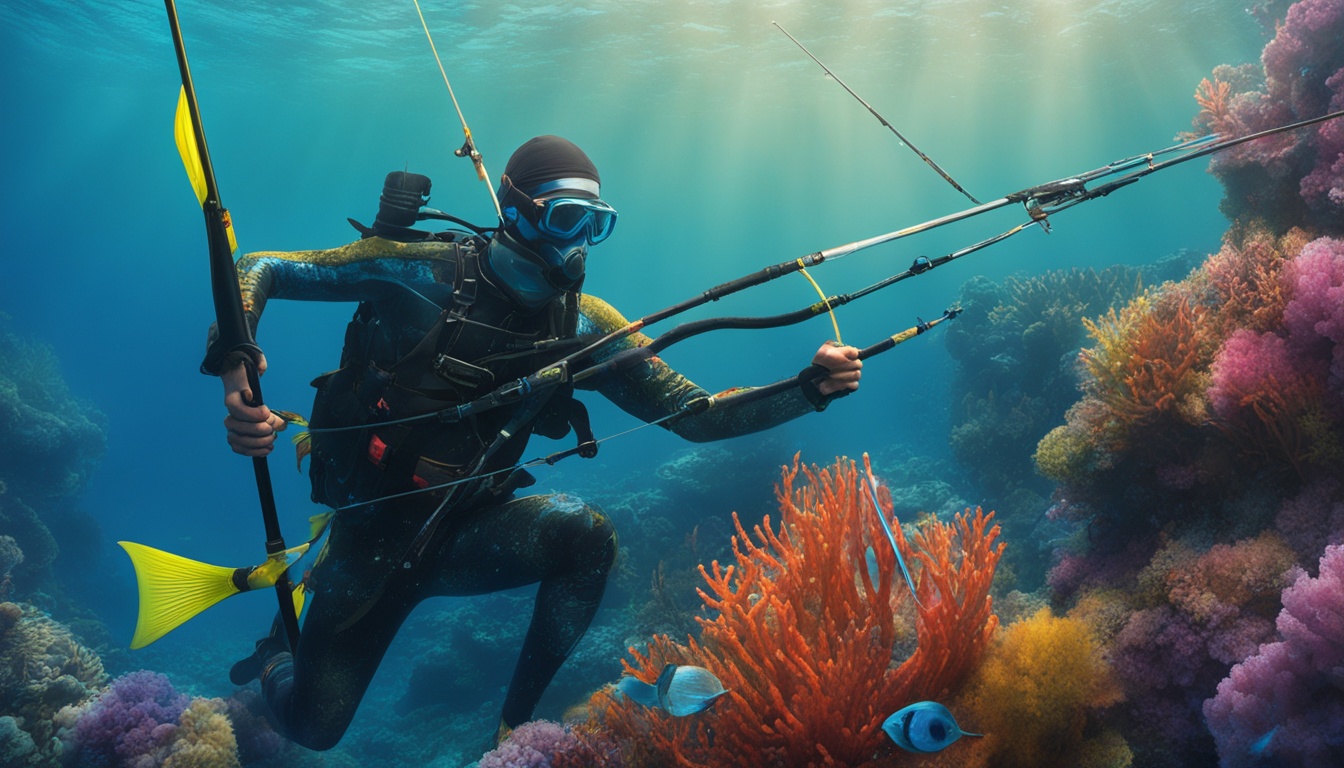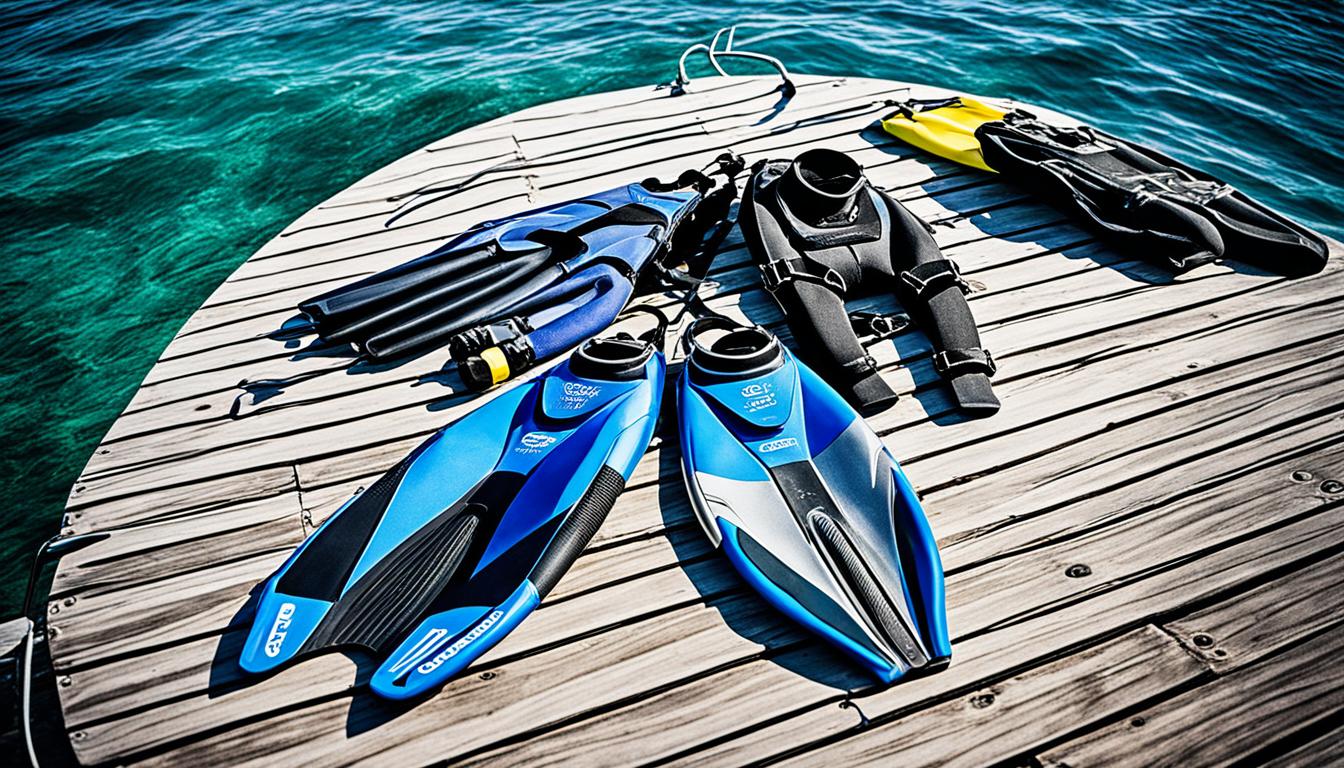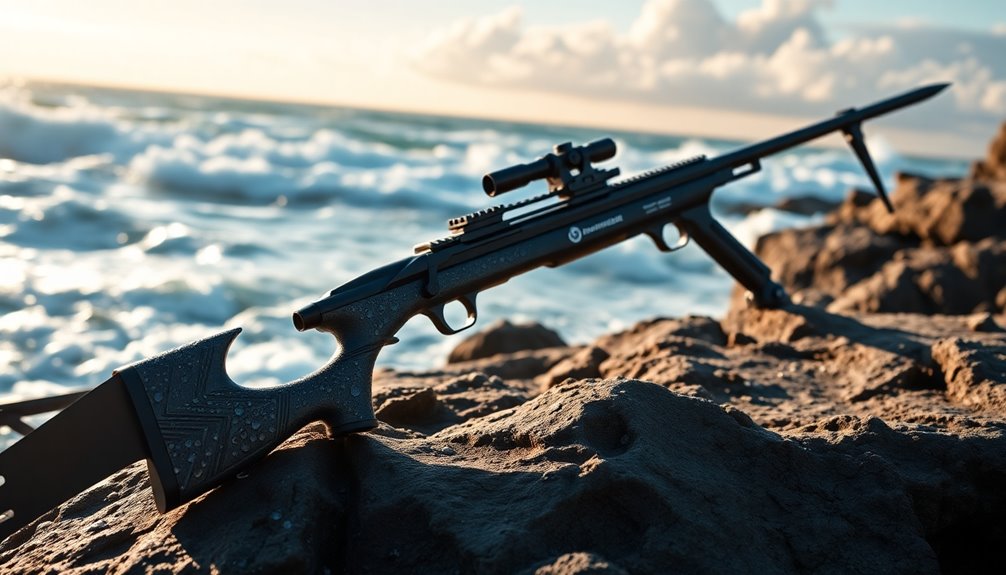Imagine yourself out on the open water, surrounded by the beauty of the ocean. As a spearo, you’re eager to dive deep and explore the marine world beneath the surface. But before you take the plunge, it’s crucial to ensure that your spearfishing float line setup is in order. After all, having the right equipment can make all the difference in the success and safety of your diving experience.
When it comes to spearfishing gear, simplicity is key. Over-complicating your gear can lead to unnecessary hassle and reduced efficiency. That’s why it’s important to focus on a basic setup that includes essential equipment like spearguns, rigline, speed spike, float, and flag. Your spear gear packing essentials should also include a wetsuit, mask, snorkel, and fins to ensure comfort and mobility in the water. By keeping your setup minimal but complete, you can focus on honing your skills and being fully prepared for the dive, without being weighed down by unnecessary equipment. Proper maintenance and organization of your spear gear packing essentials will further enhance your overall experience and safety.
One of the critical components of your spearfishing setup is the float line. This line connects you to your float, providing visibility, navigation, and safety. Setting up and managing your float line properly is essential for a stress-free dive.
Key Takeaways:
- Properly setting up and managing your float line is essential for stress-free diving.
- A basic spearfishing float line setup includes essential equipment like spearguns, rigline, speed spike, float, and flag.
- Keep your float line setup simple to avoid unnecessary complications.
- Understanding different types of floats and dive flags is essential for safety and compliance with local regulations.
- Consider float line materials and their advantages and disadvantages.
In the upcoming sections, we will dive into the details of spearfishing float line setup. From choosing the right length of float line to selecting the appropriate float type, rigging techniques, and troubleshooting common issues, you’ll gain the knowledge and skills necessary to optimize your dive.
Choosing the Right Length of Float Line
When it comes to spearfishing, selecting the appropriate length of float line is crucial. Using a float line that is too short can restrict your movement, while a line that is too long can cause unnecessary inconvenience. To ensure a successful and enjoyable diving experience, it is important to choose the right float line length based on the diving depth and the conditions you will encounter.
The majority of spearfishers suggest using a 100-foot float line when diving in kelp-rich areas. This is because kelp forests often have quick fish movements, requiring a longer line to maneuver effectively. Additionally, the line requirements in kelp-heavy regions make a 100-foot float line a popular choice among experienced divers.
However, recommendations for float line lengths vary slightly from user to user, with lengths ranging from 75 to 100 feet. The specific length often depends on the dive depth and personal preferences. It is important to consider the depth at which you will be spearfishing and choose a float line length accordingly.
Visibility is another crucial factor to consider when selecting a float line. Choosing a high-visibility color, such as yellow, can greatly enhance your safety in the water. Bright colors make it easier for others to spot you above the water, reducing the risk of boat strikes and facilitating quick assistance if needed.
Integrated floatline bungee combos have gained popularity among spearfishers for their stretchability and ease of handling. Bungees play a crucial role in fighting fish, as they absorb shock and reduce the pressure on soft-fleshed species like mackerel and wahoo. The general consensus is that a bungee can make it harder for the fish to rest during a fight, increasing your chances of a successful catch.
Many spearfishers emphasize the importance of having more line than needed. This additional line serves multiple purposes, including safety and efficient fish fighting. It is recommended to choose a float line that is at least twice the depth of your dive to ensure you have enough slack to maneuver without restrictions.
Specific product recommendations are often made for float line bungees, indicating users’ preferences for particular brands or types. Some spearfishers also discuss the advantages of bungees in situations where fish may wrap around kelp or structures, as the stretchability of the bungee helps prevent line tangles and snags.
Adapting your float line setup to different diving environments is essential for enhancing effectiveness and safety. Using longer lines in areas with strong currents provides stability, while shorter lines work better in calmer waters. By carefully selecting the right length of float line and considering the specific conditions you will be diving in, you can ensure a well-prepared and secure spearfishing adventure.
| Float Line Type | Recommended Depth | Benefits |
|---|---|---|
| Braided Rope Float Line | Less than 20m | Durable, provides some stretch |
| Foam Filled Float Line | Beginners | Highly buoyant, ideal for learning |
| PVC Float Line | Longer than 20m | Durable, can wear through if punctured |
Selecting a Float Type
When it comes to spearfishing, choosing the right float type is crucial for a successful and enjoyable diving experience. There are several types of floats available, each with its own advantages and considerations. Let’s explore the different options to help you make an informed decision.
Hard Floats
Hard floats are known for their durability and ruggedness, making them an excellent choice for spearfishing in rocky environments. These floats are typically made of hard plastic or foam-filled shells, providing exceptional buoyancy in the water. Hard floats offer stability and can withstand rough conditions, ensuring your gear stays secure.
One downside to hard floats is their bulkiness, which can make them less practical for travel. However, if you prioritize durability and reliability, hard floats are an ideal option.
Soft Floats
Soft floats, on the other hand, are preferred by many spearfishers for their portability and ease of use. These floats are often made of inflatable materials or soft foam, allowing them to be compacted for transport. Soft floats are lightweight and easily maneuvered in the water, making them suitable for both beginner and experienced spearfishers.
However, it’s essential to note that soft floats may be more prone to damage, especially in rocky environments. Additionally, soft float lines made from plastic rope can tangle easily, requiring careful winding to avoid frustrations during your diving session. Despite these considerations, the convenience and versatility of soft floats make them a popular choice.
DIY Floats
For those who enjoy a hands-on approach, DIY floats offer a cost-effective and customizable option. DIY floats can be created using various materials like boogie boards or repurposed items to suit your preferences. By utilizing DIY fish stringers made from stainless steel cable and bars, you can easily craft a float that meets your specific needs.
While DIY floats can be a fun and creative project, it’s important to remember that they may not provide the same reliability and durability as commercially available floats. If you choose to go the DIY route, be sure to consider the potential limitations and evaluate the risks involved.
Inflatable Floats
Inflatable floats offer a unique combination of portability and versatility. These floats are typically made from durable materials that can withstand rugged conditions while being easily deflated for travel. Inflatable floats are lightweight and can be packed into a compact size, making them an excellent choice for spearfishing excursions.
It’s important to select high-quality inflatable floats to ensure reliable performance and minimize the risk of punctures or leaks. Additionally, always carry a repair kit to address any potential minor damages that may occur during your dive.
When selecting a float type for your spearfishing adventures, consider factors such as your diving environment, travel needs, and personal preferences. By choosing the right float, you can enhance your diving experience and enjoy a successful day in the water.
Rigging Your Float Line
Properly rigging your float line is essential for a successful and efficient spearfishing experience. This section will guide you through the process of attaching your float line to a buoy float, connecting your spearfishing gear to the float line, securing a fish stringer, and adding any additional accessories you may need.
Attaching the Float Line to the Buoy Float
To begin, find a suitable attachment point on your buoy float. This can be a D-ring or loop specifically designed for connecting a float line. Attaching the float line to the buoy float should be secure to prevent any accidental detachment during your dives.
First, locate the attachment point on your float line. It is typically a loop or clip at the end of the line. Connecting the spearfishing gear to the float line can be done by threading the attachment point of the float line through the attachment point on the buoy float and securing it tightly.
Make sure to test the connection by giving it a gentle tug to ensure it is secure. This step is crucial for the safety and effectiveness of your float line setup.
Securing a Fish Stringer
When spearfishing, it is important to have a secure method to carry your catch underwater. A fish stringer is a common accessory used by spearfishers to secure their catch without impeding movement.
To secure a fish stringer, attach it to the float line at a point that allows easy access and does not interfere with your movement or gear. This can be done by using a clip or swivel designed for attaching a fish stringer.
Ensure that the fish stringer is securely attached and can withstand the weight and force of your catch. A strong and reliable connection is crucial to prevent any accidental loss of your catch.
Adding Additional Accessories
In addition to the main components of your float line setup, there may be other accessories you want to add to enhance your spearfishing experience.
Some common additional accessories include float line clutch technology for automatic lock when fighting a fish, reels for targeting big fish, and bungees for absorbing pressure during fights or to relieve tension caused by current or swell.
When adding these accessories, ensure that they are securely attached to the float line and do not impede your movement or create unnecessary drag. Test the attachments and make any necessary adjustments before heading out for your dive.

Following these steps will help you properly rig your float line for a successful spearfishing adventure. Remember to always inspect the connections between your float line, gear, and accessories regularly to ensure their integrity and prevent any equipment failures. With a well-rigged float line, you can confidently explore the underwater world and maximize your spearfishing experience.
Stay tuned for the next section, which will cover managing your float line in different conditions.
Managing Your Float Line in Different Conditions
As a spearfisher, it’s crucial to know how to effectively manage your float line in various underwater conditions. Whether you’re diving in the surf or dealing with strong winds and currents, proper float line management ensures a safe and successful diving experience. Here are some essential tips to help you navigate different situations:
1. Managing Float Line in Surf
Diving in the surf can present unique challenges due to the wave action and strong currents. To effectively manage your float line in these conditions:
- Choose a float line length that provides enough slack to handle the waves but doesn’t drag too much in the water.
- Use a bungee cord attached to your float line to absorb the impact of the waves, preventing excessive tension on the line.
- Ensure your float line is securely attached to your buoy, using reliable knots or clips to prevent accidental detachment.
2. Dealing with Wind and Current
When encountering windy conditions and strong currents, you need to adapt your float line management techniques. Here’s what you can do:
- Adjust the amount of extra line on your reel compared to the water depth. It’s recommended to have 25% to 50% more line than the depth you’re diving in.
- Monitor the direction of the wind and current to position yourself strategically and prevent unnecessary line tangles.
- Consider using a longer and more buoyant float to help counterbalance the effects of wind and current.
3. Using Bungee Cord for Float Line
Using a bungee cord in your float line setup provides added flexibility and shock absorption. Here are some ways to optimize its usage:
- Attach the bungee cord to both ends of your float line to create tension and reduce the risk of tangling.
- Ensure the bungee cord has an appropriate length to allow for a full range of movement without restricting your dive.
- Regularly inspect the bungee cord for signs of wear and tear, and replace it if necessary to maintain safety.
4. Shortening Float Line Temporarily
Situations may arise when you need to temporarily shorten your float line. Here’s a simple technique to do it:
- Detach the end of your float line from the buoy and remove any excess line that you don’t need.
- Create a secure loop using reliable knots, ensuring that it won’t come undone during your dive.
- Reattach the shortened float line to the buoy, ensuring a tight connection to prevent any unwanted twists or tangles.
By implementing these techniques, managing your float line becomes more efficient and adaptable to different diving conditions. Remember to prioritize safety and regularly inspect your gear to ensure everything is in proper working order.

Troubleshooting Common Float Line Issues
While spearfishing, it’s not uncommon to encounter float line issues that can disrupt your diving experience. However, with the right knowledge and techniques, you can easily troubleshoot these problems and ensure a smooth and successful dive. In this section, we’ll explore some common float line issues and provide practical solutions to tackle them.
Untangling Float Line
Untangling a tangled float line can be frustrating, but it’s a skill that every spearfisher should master. To untangle the line, take your time and follow these steps:
- Remove any tension by swimming toward the tangled section.
- Hold the line firmly and locate the point of entanglement.
- Slowly unravel the line by gently pulling it apart.
- If the tangle is severe, you may need to detach the line temporarily and untangle it on the surface.
- Once untangled, reattach the line securely and continue your dive.
Repairing Float Line
If you notice small gashes or cuts in your float line, it’s essential to repair them promptly to prevent further damage. Follow these steps to repair your float line:
- Trim any loose threads or frayed edges around the damaged area.
- Apply a waterproof adhesive or repair tape to seal the gash.
- Ensure the repair is secure and wait for it to dry completely before using the float line again.
Preventing Float Line Twists
Float line twists can hinder your movement underwater and create unnecessary drag. Here’s how you can prevent float line twists:
- Regularly check your float line for twists before each dive.
- Secure the line properly to your buoy or float to minimize twists.
- Avoid unnecessary movements or sudden jerks that could tangle the line.
Maintaining Bungee Cord
The bungee cord plays a crucial role in managing the tension between you and your buoy or float. Here are some tips to maintain the bungee cord:
- Inspect the bungee cord regularly for signs of wear and tear.
- Replace the cord if it becomes frayed or loses elasticity.
- Clean the bungee cord with freshwater after each dive to remove salt and debris.
- Store the bungee cord properly to prevent tangling or damage.
Solving Buoyancy Problems
Buoyancy problems can disrupt your diving experience and affect your overall control underwater. Here are some solutions to address buoyancy issues:
- Ensure your buoy or float is properly inflated to the recommended level.
- Adjust the length of your float line to maintain optimal buoyancy.
- If using a reelgun, be mindful that adding a reel may affect the gun’s ability to float.
- Consider using sturdy fins to maintain control and prevent entanglement risks.
By following these troubleshooting tips and techniques, you’ll be better equipped to handle float line issues that may arise during your spearfishing adventures. Remember, proper maintenance, regular inspection, and quick problem-solving will ensure a seamless and enjoyable diving experience.

Expert Tip
“To avoid float line issues altogether, it’s crucial to invest in a high-quality float line and regularly maintain it. Don’t compromise on the quality of your gear, as it directly impacts your safety and success as a spearfisher.” – John Smith, Professional Spearfisher
Tips for Traveling with Your Float Line Setup
If you’re an avid spearfisher who loves to travel, it’s crucial to know how to pack and transport your float line setup effectively. Whether you’re packing for a local weekend getaway or a dream spearfishing destination, these tips will ensure that your float line is ready for action.
1. Choosing a Portable Float Line
When traveling, it’s important to consider the size and weight of your float line setup. Opt for a portable float line that is lightweight and compact, making it easier to pack in your travel bag or carry-on. Look for float lines made from durable materials, such as foam-filled poly lines, which offer excellent durability against abrasions while remaining lightweight.
2. Packing Your Float Line for Travel
Properly packing your float line is essential to prevent tangling and damage during transportation. Before packing, make sure to clean and dry your float line thoroughly. Coil it neatly and secure it with zip ties or rubber bands to keep it organized. Place it in a sturdy bag or case to protect it from any external pressure or impact.
3. Airline Travel Considerations
If you’re planning to travel by air with your spearfishing gear, be aware of the airline’s regulations and restrictions. Contact the airline in advance to inquire about any specific requirements and limitations for transporting spearfishing equipment. It’s advisable to carry your float line as carry-on luggage to minimize the risk of damage or loss.
4. Compliance with Local Laws and Regulations
Before embarking on your spearfishing adventure, familiarize yourself with the local laws and regulations regarding the use of floats and buoys. Some locations may have specific requirements, such as the size of the flag or the distance allowed from the float. Always ensure that you comply with these regulations to ensure your safety and legality while spearfishing.
5. Additional Tips
Here are a few additional tips to consider when traveling with your float line setup:
- Invest in good swivels at the top and bottom of the float line to prevent twisting and ensure smooth operation.
- Consider using inflatable torpedo floats as a suitable option for your spearfishing setup, recommended by the Neptonics store in Tampa.
- Keep a copy of the local laws and regulations pertaining to spearfishing and float line setups for reference.
- If you plan to store your fish on the float, make sure to secure them properly to avoid any accidental loss.
By following these tips, you can travel with your float line setup safely and enjoy spearfishing in different locations without any hassle or worries. Remember to always prioritize safety and compliance with local laws, and you’ll have a fantastic spearfishing experience wherever you go.

| Statistics | Brief Explanation |
|---|---|
| The mentioned 5/16″ blue steel rope has a breaking strength in excess of 1000 pounds | It is highly durable and suitable for various applications, including spearfishing. |
| The blue steel rope was purchased for approximately $70 for a 600-foot length | It provides a cost-effective and robust solution for float line setups. |
| Foam-filled poly lines with swivel tuna clips were recommended for a bomb-proof float line setup | They offer excellent durability against abrasions. |
| The foam-filled poly line, paired with swivel tuna clips and a bullet-shaped lobster float | It proved to be an effective combination for withstanding reef conditions and resisting punctures. |
Maintenance and Care for Float Line Setup
Proper maintenance and care are essential for keeping your float line setup in top condition and ensuring its longevity. By regularly cleaning, inspecting, and storing your float line correctly, as well as replacing any worn-out components, you can extend its lifespan and optimize its performance. Here are some crucial tips to help you maintain and care for your float line setup:
Cleaning your Float Line
Cleaning your float line after each use is important to remove any dirt, salt, or other debris that may accumulate. This helps prevent damage and keeps your float line functioning optimally. To clean your float line:
- Fill a basin or bucket with warm water and add a mild detergent.
- Submerge the float line in the soapy water and gently scrub it with a soft brush or cloth.
- Rinse the float line thoroughly with fresh water to remove all detergent.
- Hang the float line to air dry completely before storing it.
Inspecting your Float Line for Damage
Regularly inspecting your float line for any signs of wear or damage is crucial for maintaining its integrity and safety. Check for the following:
- Examine the entire length of the float line for cuts, fraying, or abrasions.
- Inspect the connections and attachments, such as snap hooks, clips, and swivels, for any signs of rust, corrosion, or weakening.
- Ensure that the knots and knots around the float line are secure and intact.
If you notice any damage or wear, it is essential to replace the affected components promptly to prevent accidents or equipment failure.
Storing your Float Line
Proper storage of your float line is crucial for maintaining its condition and preventing tangling or damage. Follow these tips when storing your float line:
- Ensure the float line is completely dry before storing it to prevent mold or mildew growth.
- Avoid exposing the float line to direct sunlight or extreme heat, as it can degrade the materials.
- Store the float line in a cool, dry place away from sharp objects or any potential hazards.
- Avoid tightly coiling the float line, as it may cause kinks or twists. Instead, loosely coil it or hang it on a dedicated float line rack.
Replacing Worn-out Components
Over time, certain components of your float line setup may wear out or become damaged. It is crucial to replace these components to maintain the overall functionality and safety of your setup. Here are some components to pay attention to:
- Snap hooks, clips, and swivels: Check for signs of rust, corrosion, or weakened strength. Replace any compromised components.
- Floats: Inspect the floats for cracks, holes, or other damage that may compromise their buoyancy. Replace any damaged floats.
- Shooting line: Monitor the shooting line for fraying, cuts, or excessive wear. Replace the shooting line if necessary.
- Float line adaptors: If your float line adaptors show signs of wear or are not functioning properly, consider replacing them to ensure a secure connection between your speargun and float line.
By following these maintenance and care practices, your float line setup will remain in excellent condition, providing you with reliable performance and enhancing your spearfishing experience.

Advanced Techniques and Tips for Float Line Setup
Congratulations on mastering the basics of float line setup! Now it’s time to take your spearfishing skills to the next level with advanced techniques and specialized accessories. In this section, we will explore advanced float line rigging techniques, recommend specialized accessories for your float line setup, and provide advanced float line management techniques. These tips and tricks will help you optimize your spearfishing experience and increase your chances of success.
One of the key advanced float line rigging techniques is using the right length of float line. By choosing the optimal length, you can ensure that your float line effectively maintains the appropriate distance between you and your catch. This allows for better accuracy and prevents fish from tangling in the line.
Specialized accessories for float line setup can greatly enhance your spearfishing endeavors. One essential accessory is the ‘Buzz Bomb’ flasher, a highly regarded South African product. This innovative flasher is known for its ability to attract big pelagic fish, increasing your chances of a successful hunt. Additionally, utilizing the Brummel Lock & Hollow Core Dyneema Slicing technique for your spearfishing shooting line can provide exceptional strength and durability, ensuring that your setup is reliable and secure.
Advanced float line management techniques play a crucial role in maximizing your success underwater. When it comes to managing your float line in different conditions, it is important to consider factors such as tides and sea conditions. Spearfishing with the tides can be particularly productive, as tidal regions often attract a variety of marine life. By adapting your hunting strategy to align with the tides, you can improve your chances of encountering a diverse range of fish.
It is worth noting that advanced float line setup is not without risks. When engaging in cave hunting, where spearos target hidden fish in underwater caves, it is essential to exercise caution and be aware of the potential dangers associated with these environments. Prioritizing safety measures and honing your proficiency in advanced techniques before attempting cave hunting is of utmost importance.
To ensure your gear is properly set up for advanced spearfishing techniques, it is crucial to understand the standard versus full pretension preload on rollerguns. This can greatly impact the performance of your rollergun setup. Additionally, correctly pretensioned rollerguns using 16mm or 18mm bands require the right load assist for loading the speargun efficiently and effectively.
Lastly, it’s important to mention the value of proper maintenance and care for your float line setup. Regularly checking and maintaining your equipment will prolong its lifespan and ensure optimal performance during your spearfishing adventures.
By incorporating these advanced techniques, utilizing specialized accessories, and mastering float line management, you can elevate your spearfishing game and increase your chances of success in the water.
Conclusion
In conclusion, the proper setup of your spearfishing float line is crucial for a successful and enjoyable diving experience. Throughout this guide, we have covered key aspects of float line selection, rigging, management, troubleshooting, and maintenance.
By choosing the right length of float line and selecting the appropriate float type, such as rope float lines for shallow water spearfishing or Spectra and Dyneema float lines for high-performance diving, you can optimize your safety and performance.
Remember that your float line serves as a guide in challenging conditions, helping to lead you back to safety in strong currents or low visibility. If you dive in groups, strategically deploying multiple float lines can enhance movement range and overall safety.
Additionally, incorporating a bungee float line with elasticity and shock absorption can aid in targeting powerful fish that make sudden movements, while a line release system enhances safety and convenience during emergencies or while dealing with large catches.
Using a float line setup significantly reduces the risk of losing your speargun, provides a secure place to keep fish underwater, and offers a cost-effective option for spearfishers, especially beginners. And don’t forget, choosing foam-filled float lines can provide durability and buoyancy for a reliable spearfishing setup.
With these key takeaways from the guide, you are now equipped to optimize your spearfishing float line setup and embark on exciting underwater adventures with confidence.










